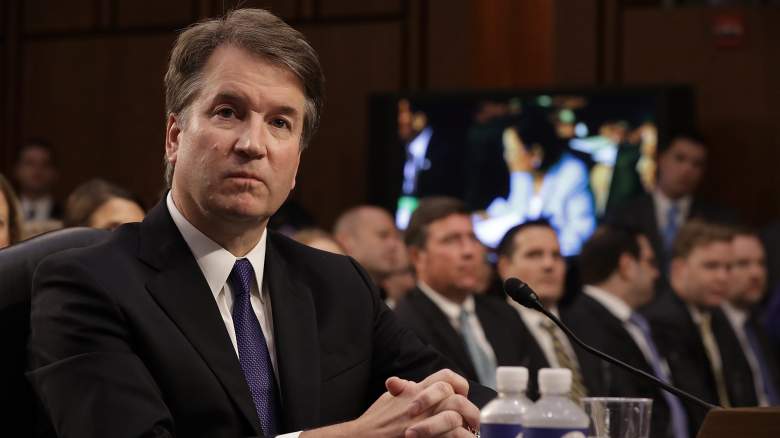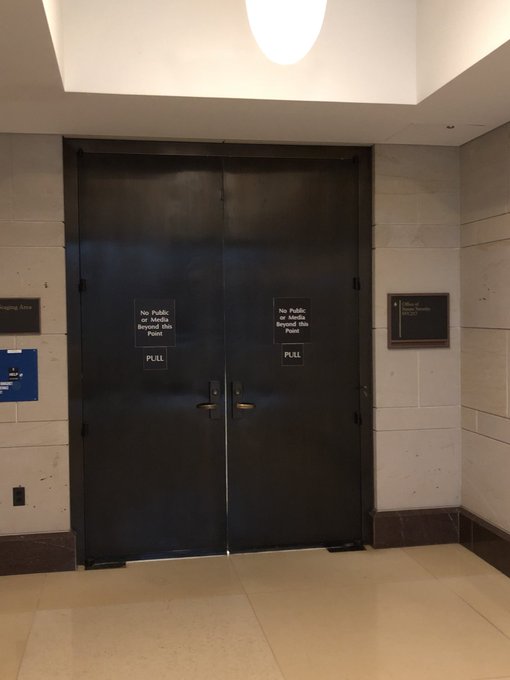
Getty Brett Kavanaugh
On Thursday, as the deadline approached for a cloture vote on Brett Kavanaugh’s nomination to the Supreme Court, senators began filing into a special reading room in the Senate building known as a Sensitive Compartmented Information Facility, or SCIF. (It’s pronounced “skiff.) Senators entered the SCIF so that they could read the FBI’s new report on the allegations against Kavanaugh. The report is not, strictly speaking, confidential. But senators may not take it home with them, or report on any of its findings; they may only read it while in the SCIF.
Chuck Grassley, the chair of the Senate Judiciary Committee, tweeted late Wednesday night that he and Dianne Feinstein had received the report and that senators would be granted access to see it on Thursday. President Trump has also been briefed on the report’s contents.
Here’s what you need to know:
1. Senators Can Read the FBI Report in the Secure Chamber, Following a Strict Order
Grassley tweeted at 4AM that the report was ready and that all 100 senators would be allowed to read it. But that doesn’t mean that all 100 senators could run over to the SCIF and read the report right away. Like almost everything in the senate, access to the report follows a strict set of rules, painstakingly established over the years.
First, at 8AM on Thursday, Grassley himself was allowed to enter the SCIF, or reading room, and examine the report himself. At 9AM the ranking Democrat on the Senate Judiciary Committee, Dianne Feinstein, had a turn to read the report. At 10, the Republicans on the Senate Judiciary Committee were allowed to enter the SCIF to read. And at 11, it’s the turn of the Democrats on the Judicary Committee.
After the committee members finish reading, the rest of the Senate has a turn to read the FBI report. Again, the report can only be read in the SCIF. Senators can’t bring their staffers in to read the report. They can’t have copies of the report to bring home. And they can’t report to the public about any of the findings in the report.
2. Democrats Are Already Objecting to the Procedure for Reading the Kavanaugh Report
The rules around who can read the FBI report — and when they can read it — are very strict. Already on Wednesday, Senator Dick Durbin, Democratic Whip, was criticizing the plans. ““Get this — one copy! For the United States Senate,” Durbin said to reporters. “That’s what we were told. And we were also that we would be given one hour for the Dems, one hour for the Republicans. Alternating.”
Tim Kaine, the former vice presidential candidate and senator from Virginia, tweeted, “The “report” is available for Senators to review in a secure office but get this—there’s only ONE copy! That means Senators have to sign up for hourlong slots between now and the expected vote. There may not even be time for all 100 of us to read it before our first vote!”
He added, “Senators can’t even discuss the report’s contents with the public. And they’re not releasing it to the public. This is an insult to Americans concerned about the future of the Supreme Court.”
Grassley, the Republican chair of the Judiciary Committee, responded that the rules are just standard operating procedure for a sensitive document. He said Democrats had not objected to the rule in the past.
According to the procedure, senators will each have an hour to read the FBI report. Democrats and Republicans will enter the secure room separately, with senators from each party getting an hour to read. Nine staffers will also be allowed into the room to read the document, so that they can brief senators who couldn’t read the document in the chamber. The names of those staffers have not been made public.
3. Senators Are Barred From Bringing Electronics into the SCIF
Every Senate and House committee has its own SCIF; in this case, senators will be using the SCIF assigned to the Judiciary Committee. But the SCIFs all have the same general look, and are governed by the same rules.
The SCIFs look just like any other room in the Capitol complex — it has a long wooden conference table and pastel walls. There are no space age computers, or special lighting, like you might see in a spy movie. But there are strict rules about who, and what, can go into the secure chambers. Only people with a security clearance can go into the SCIF at all. And even then, they must follow an established order governing when they go into the rooms.
No electronics are allowed in to the secure rooms. That means no cameras and no smartphones; it also means no recording devices can be used. The secure chambers are used so that senators (and in many cases, other people with a security clearance) can study classified or sensitive documents. There are no cameras and recording devices allowed in so that people won’t be tempted to take pictures of sensitive or classified documents. Note taking is also not allowed, which means that senators will have to rely on their memories when it’s time to debate the content of the FBI report.
4. The SCIFs Are Sound-Proof & Their Heavy Doors Open by Code
Peter King, the one-time chair of the House Homeland Security Committee, said that a SCIF is “just like any other room, but it takes a weight lifter to open the front door.” You can see from the picture that they’re made of a heavy metal. They operate on a code; senators have to punch in their access code to open the door.
A guard stands out front to collect any electronics from senators, and to ensure that only people who are allowed in the rooms are actually entering.
The rooms are also sound-proof so that passersby can’t hear what’s going on inside. That makes them a safe place to have a briefing or a private conversation. The SCIFs’ walls, floors, and ceilings also are built thick and strong; they incorporate metal grids to make it virtually impossible for anyone to force their way into them.
5. The SCIFs Have to Be Constructed by American Workers and American Companies
Just as there are complicated rules about who is allowed inside a secure reading room, there are also complicated rules about how the rooms can be built.
The Department of Defense and the Director of National Intelligence have set out pages upon pages of rules about how the SCIFs must be built. One ground rule is that only US citizens are allowed to construct the rooms. And those US citizens have to be working for US-based businesses that area accredited by the Department of Defense or another approved security agency.
Every House and Senate committee that handles classified information has its own SCIF. There is also a SCIF which can be used for other purposes not covered by the usual committees.
READ NEXT: Christine Ford’s Second Door: 5 Fast Facts You Need to Know
